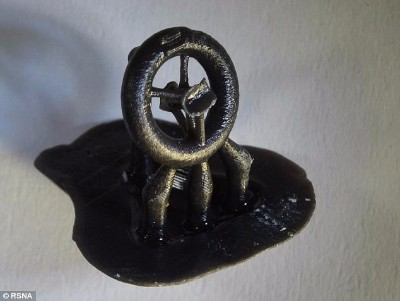Blog
-

Still a long way off but..Tiny 3D-printed ‘bones’ could be implanted into the ears of deaf people to help them hear.
 4 Dec , 2017
4 Dec , 2017
Still a long way off but..Tiny 3D-printed ‘bones’ could be implanted into the ears of deaf people to help them hear.
Experts used CT scans of a cadaver’s ears to create a 3D printed prosthetic. The three fragile bones in the middle-ear can be replaced with resin replicas. Surgeons were able to correctly match the devices to their intended recipients. The technology may offer the key to helping deaf people to hear in the future.
Revolutionary 3D printing technology may someday offer the key to helping deaf people to hear. Experts can now craft replacement parts for fragile bones, known as ossicles, which transmit external soundwaves towards the cochlear nerve.The researchers hope that these personalized devices could one day restore hearing to the deaf and profoundly hearing impaired.
Researchers at the University of Maryland in Baltimore came up with the concept, which uses CT scans of a patient’s ear to create a 3D printed prosthetic.
Currently, surgeons create them in the operating room, but they often fail because they don’t fit correctly.
By using CT imaging, the team was able to take detailed measurements of an individual’s inner ear and use a standard 3D printer to create the synthetic bones.
Dr Jeffrey Hirsch, co-author of the study, said: ‘The ossicles are very small structures, and one reason the surgery has a high failure rate is thought to be due to incorrect sizing of the prostheses. ‘If you could custom-design a prosthesis with a more exact fit, then the procedure should have a higher rate of success.’
Hearing works through the transmission of vibrations from the outside world into the ear drum and on to the cochlea – the sensory organ of hearing.
The ear does this through these three tiny bones in the middle ear known as ossicles.Ossicular conductive hearing loss is a form of deafness caused by damage to these bones, usually from trauma or infection. This affects the passage of sound between the ear drum and the inner ear, with sound vibrations not reaching the cochlea.
Currently, treatment focuses around surgical reconstruction using stainless steel struts and ceramic cups.
In the study, the researchers removed the ossicles from three dead bodies and took a CT scan to get specific measurements. They then used a 3D printer to create replicas to replace the bones they had removed. The prostheses were made from a resin that hardens when exposed to ultraviolet laser light.
Four surgeons were part of a blind study where they inserted each prosthesis into each middle ear, with no idea which corpse it had been designed to fit.
They were asked to match each prosthesis to its correct source, without any previous knowledge.All four surgeons were able to correctly match the prosthesis model to its intended temporal bone – the bone containing the middle and inner parts of the ear.
Dr Hirsch said the chances of this occurring randomly are 1 in 1,296, adding: ‘With these models, it’s almost a snap fit.’
Combining CT scans and 3D printing not only increased the likelihood of a proper fit, it also decreased surgical time.
The next step is to create prostheses that would combine the 3D-printed prostheses with stem cells.
Dr Hirsch added: ‘Instead of making the middle ear prosthesis solid, you could perforate it to be a lattice that allows stem cells to grow onto it.
‘The stem cells would mature into bone and become a permanent fix for patients with hearing loss.’Source: The Daily Mail
Image credit:RSNA





























































































































































































































































































































































































































































































































































































